Anthuriums - a large genus of plants of tropical origin, cultivated indoors since the second half of the last century. Among flower lovers, it is extremely popular due to beautiful foliage, spectacular flowering and ease of care.
Material Content:
Species and varieties
Of the 900 plant species of the genus Anthurium, 3 are cultivated under artificial conditions: Anthurium Andre, Anthurium Scherzer and Anthurium Khrustalny.
Anthurium Andre
It is characterized by a shortened trunk, to which large (25-30 cm with a width of 8 to 13 cm) oval-lanceolate leaves are attached using long (up to 35 cm) and curved cuttings. When flowering, it forms an inflorescence - an ear up to 10 cm long in yellow shades, surrounded by a bract of red, pink, salmon or white tones.
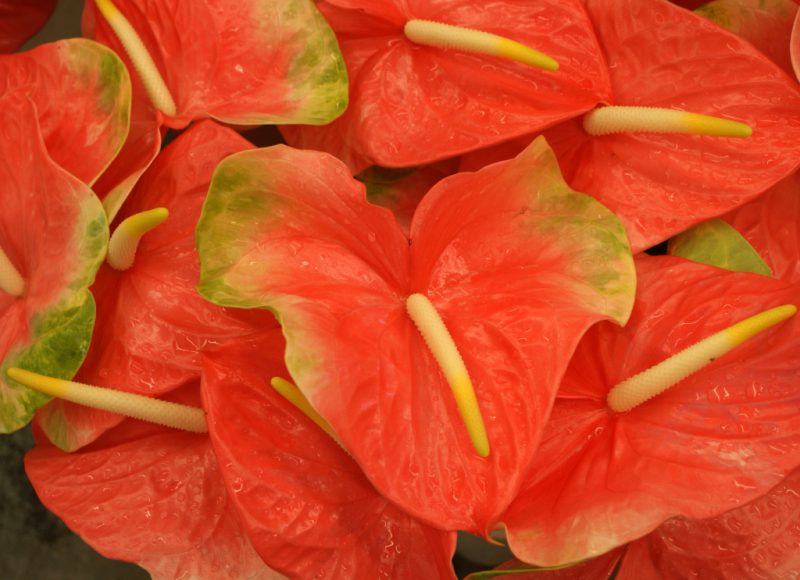
The species is the ancestor of dozens of varieties that differ in the color of the bract. Based on this feature, they are usually combined into groups. At room conditions, white and red varieties are most often grown.
- Among white varieties, White champion, White champion, Sumi and the white and pink variety Princess Amalia Elegance are popular.
- Of the red group are Dakota, Sierra Magic and Turenza.
Anthurium Scherzer
It stands out among its relatives by a spirally coiled cob surrounded by a large red-orange bract and leaves on long (6–25 cm) cylindrical petioles.

The leaf blades are elongated (linear or lanceolate), pointed, with a blunt or wedge-shaped base, painted in dark shades of green and downy. The upper side is glossy, the bottom is matte.
Popular varieties:
- Lacetti with salmon shades;
- Grafitti with a light, red speckled bract;
- Hawaii, the cover of which is painted in 2 or 3 colors;
- Alexia Bleu with a bract of gentle, sky blue tones.
Anthurium Crystal
Appreciated for the beauty of long-oval oval leaves of dark green color with light veins. The ear is greenish yellow.

Indoor cultivated varieties:
- Hooker, with large green, with small black spotting, leaves and purple or dirty purple flowers.
- Majestic, with beautiful dark green velvety and textured foliage, pierced with olive-streaked veins.
- Climbing, with creeping or clinging shoots bearing oval-elongated leathery leaves. The decorativeness of this variety is provided by attractive-looking fruits - berries in shades of orange, red, purple and white.
Anthurium flower - growing characteristics
The birthplace of Anthurium is the tropical forests of the American continent, where there is a lot of light, warm and humid. Therefore, the flower needs conditions that are as close to natural as possible. This is the key to his comfortable existence indoors.
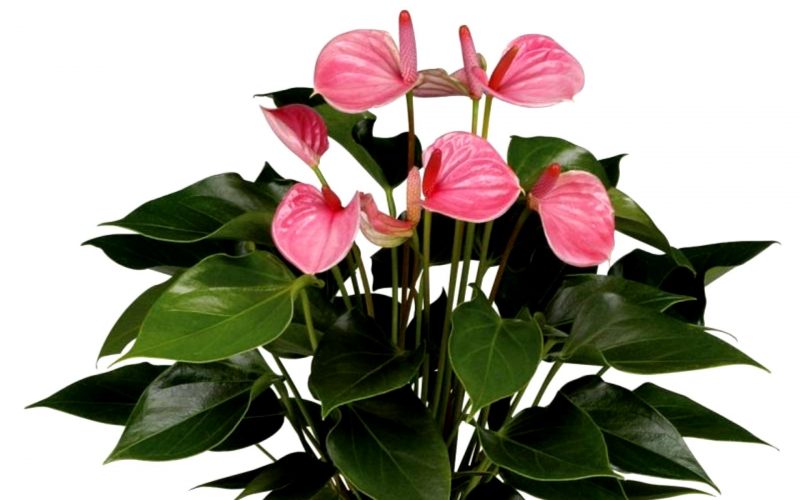
Most artificially cultivated species in autumn slow down vegetation and relax in winter, requiring coolness and a short daylight.
Anthurium care at home
The flower is easy to grow.
Care for it is to conduct watering, top dressing and infrequent transplantation.
Lighting, temperature
Anthuriums love bright diffused light. In direct sunlight, its flowers and leaves burn out. Lack of light leads to excessive stretching and exposure of the shoots.
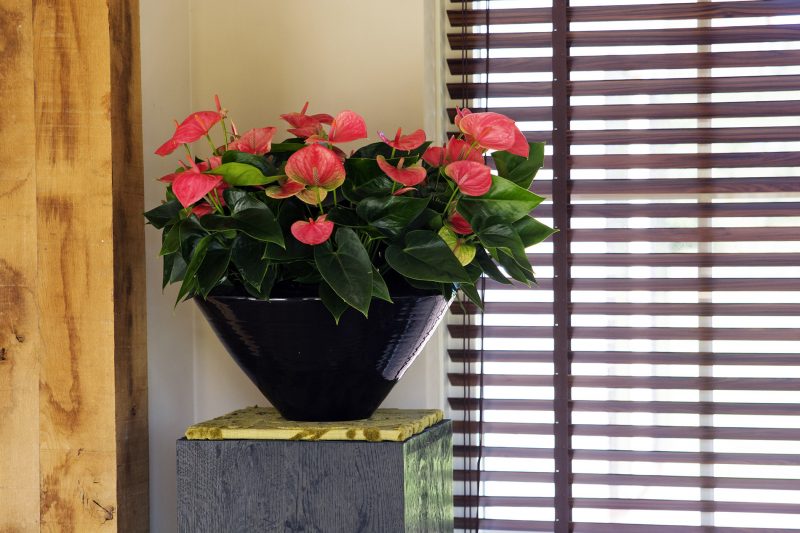
In addition to good lighting, the plant needs warm air. The flower is comfortable at room temperatures from 22 to 25 ° C. Slight (17–20 ° C) coolness at night is allowed.
The flower does not tolerate stagnation of air and drafts.
Soil requirements
For the cultivation of anthurium, a nutritious, light, loose and moisture-intensive substrate with a neutral medium is suitable (5.5-6.0). As its basis, you can take purchased soil for azaleas with the addition of broken brick or perlite. The soil mixture can be prepared independently.

There are several options for its composition:
- peeled peat, leaf soil, sand, crushed and pre-steamed bark of coniferous trees, crushed charcoal (2: 2: 1: 0.5: 0.5);
- rotted horse manure, fiber peat, pine bark, small pumice (1: 1: 1: 1);
- expanded clay, fibrous peat, pine bark (1: 1: 1);
- peat, finely chopped sphagnum, turf land (2: 2: 1);
- peat, coconut fiber, pine bark, charcoal, chopped sphagnum moss (1: 1: 1: 0.5: 1).
Before use, in order to avoid root infections and damage, the substrate is disinfected.
Watering and humidity
Anthurium is equally poorly tolerated by deficiency and excess moisture, so a properly selected watering regime is important for it.
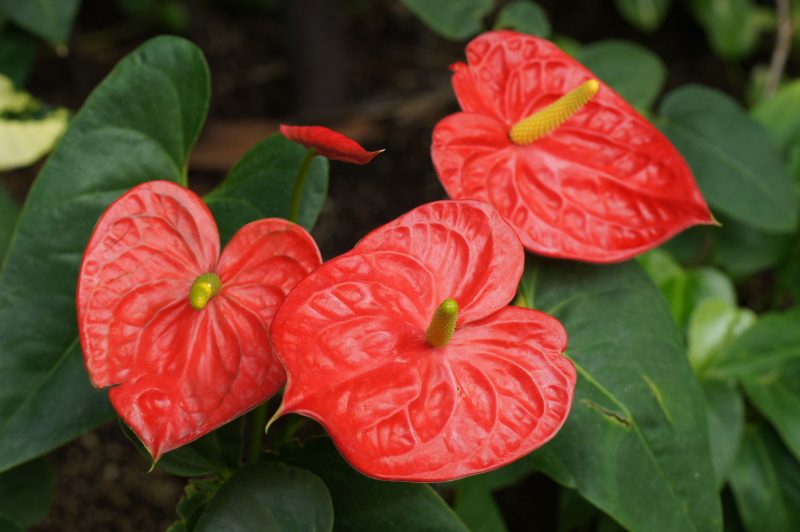
- In the summer heat and winter in a heated room, the flower is often watered. The frequency of moistening is determined by the drying of the upper soil layer.
- In winter, with artificial lengthening of daylight and keeping the flower warm, the moistening mode is not changed.
- In preparation for rest (autumn), watering is gradually reduced, minimizing it to winter (1 time per month).
Humidification is carried out with warm (2-3 degrees higher than the ambient temperature) with standing or boiled water, under the roots.
Fertilizer and fertilizer
During active growth and flowering (spring and autumn), anthurium is fed 2 times a month, alternating the use of organic and mineral fertilizers. As mineral additives, special means for orchids are used.
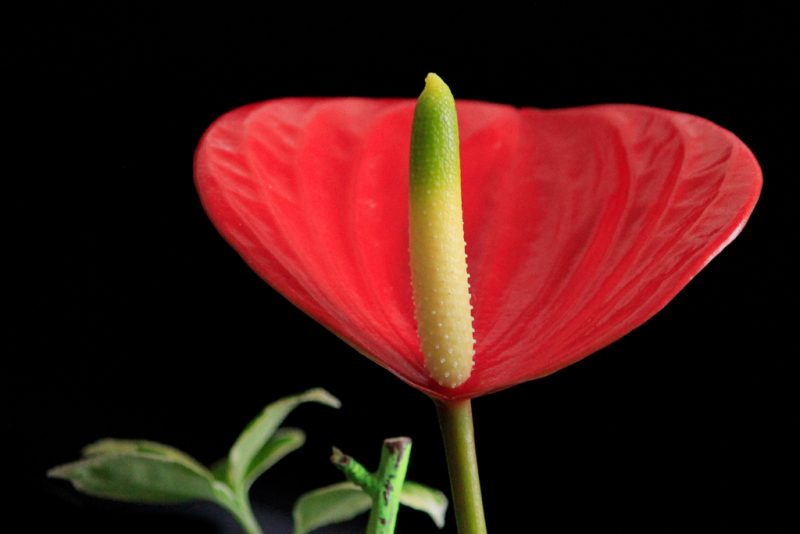
Anthurium responds well to weekly foliar top dressing with any complex fertilizer.
Anthurium transplant
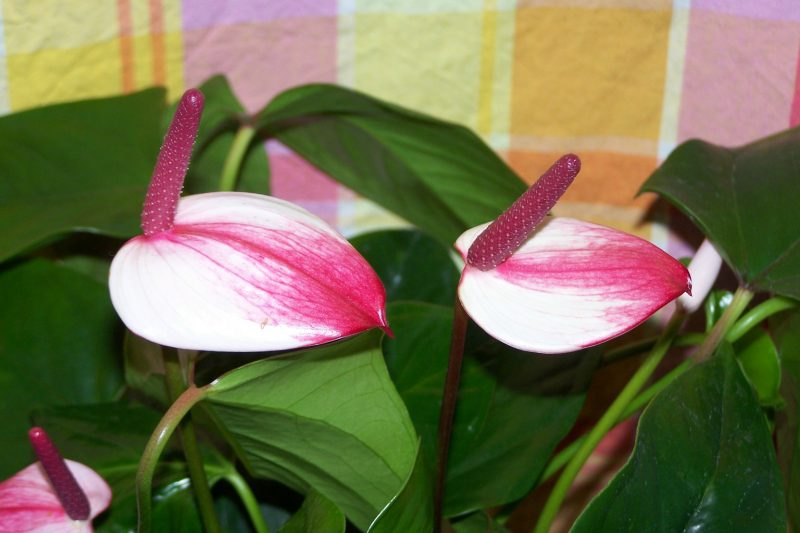
Anthurium needs transplants, the frequency of which is determined by its age:
- Young (up to 4 years old) forms are growing rapidly and therefore need an annual transplant, including replacing the tank with a slightly larger one.
- Adult specimens are transplanted once every 2-3 years.
The grounds for transplanting an adult flower are:
- full filling of the space of the pot with roots;
- acidification of the soil;
- root system diseases.
In most cases, anthurium transplantation is carried out by the method of transshipment. The exception is plants with diseased roots.
Before the procedure, the flower is abundantly watered. The earthball should be completely saturated with moisture.
After that:
- a drainage layer is laid at the bottom of the container;
- about a third of the volume of the pot is covered with soil;
- In the center of the tank, an earthen lump with a plant is installed, the voids are filled with the remaining substrate.
Transplanted anthurium for 3-4 days is placed in the shade.
Transplantation of diseased plants is carried out after the preliminary release of the roots from the ground, their inspection and removal of unhealthy areas.
Pot recommendations
To grow anthurium, use plastic or glass wide shallow containers.
Ceramic pots are better not to use: the roots of anthurium grow into their surface.
Rest period
From the end of autumn and all winter, Anthurium rests.
At this time, there is active work at the cellular level. The plant forms flower buds. The decorativeness of the future flowering depends on their quantity and quality. That is why providing such a period for this flower is so important.

To book flower buds you need coolness and a short daylight hours.
With room content, these conditions are created artificially:
- in autumn, the flower is transferred to a cooler place;
- gradually reduce the intensity of watering;
- stop feeding.
Anthurium reproduction
The plant under discussion among flower growers is also known as "male happiness." And you always want more happiness! Anthurium is propagated by seeds and vegetatively.
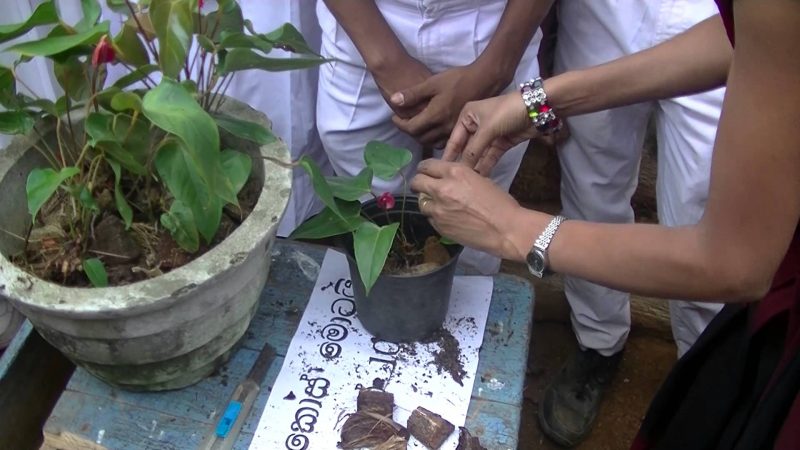
Growing from seeds is difficult, because planting material is very rare on sale. Self-production is long and does not guarantee germination. Therefore, anthurium is propagated by seeds extremely rarely - only to obtain new hybrids.
Vegetative propagation is easier and faster. It allows you to get new plants while preserving all the signs of the maternal form.
It is carried out using:
- cuttings;
- basal shoots;
- layering;
- dividing the bush.
Cuttings
The most common way is to grow anthurium of their apical and stem cuttings. Their harvesting is carried out in spring and summer, cutting off the side shoots.

- The tops of shoots up to 10 cm long with 1-2 pairs of leaves are used as apical cuttings. The remaining part of the branch is freed from foliage and divided into parts of 5-8 cm. These are stem cuttings.
- The apical cuttings are rooted in settled water at room temperature or in a substrate consisting of perlite and clean sand, closing the containers with a transparent, airtight material.
- Stem - in wet sand, perlite or moss, covering the container with glass or film.
- To grow roots, cuttings need heat (from 20 ° C) and light. I air the landings daily. Moisturize the soil as it dries.
Under these conditions, the roots are formed after 3 weeks. After the leaves appear, young plants are transplanted into separate containers and looked after as adults.
Aerial roots form in the upper part of the shoots of some types of anthurium. Their presence greatly simplifies the procedure. Such a stalk is planted immediately with a soil mixture.
Propagation by root shoots
An adult plant actively increases lateral shoots, often departing immediately from the rhizome. This is the root shoot. In spring or summer, it can be carefully separated, and put in separate containers filled with substrate.
Layering or side shoots
Compared with the previous options, a less laborious, but longer way to get new plants.
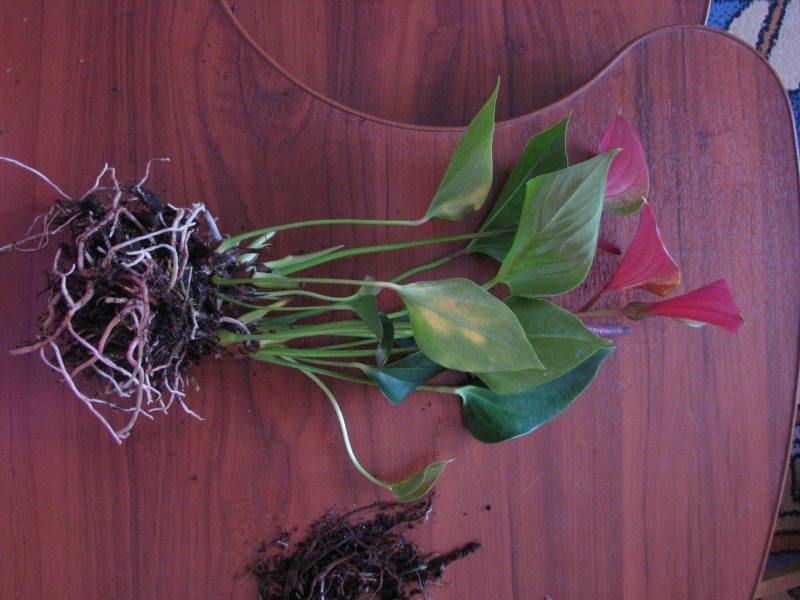
To conduct it, part of the shoot of anthurium is freed from the leaves and wrapped with wet sphagnum, covered with a plastic film on top.
Within 3-4 months, roots form under a layer of moss. The shoot section is separated and planted in an individual pot.
Bush division
The division is subject to adult and overgrown bushes. It is carried out from the second half of February to May, often combining with a transplant. The method is also good as an anti-aging procedure.
If at this time the anthurium blooms, then the peduncles are cut, which will significantly reduce the loss of strength and accelerate the adaptation of the plant.
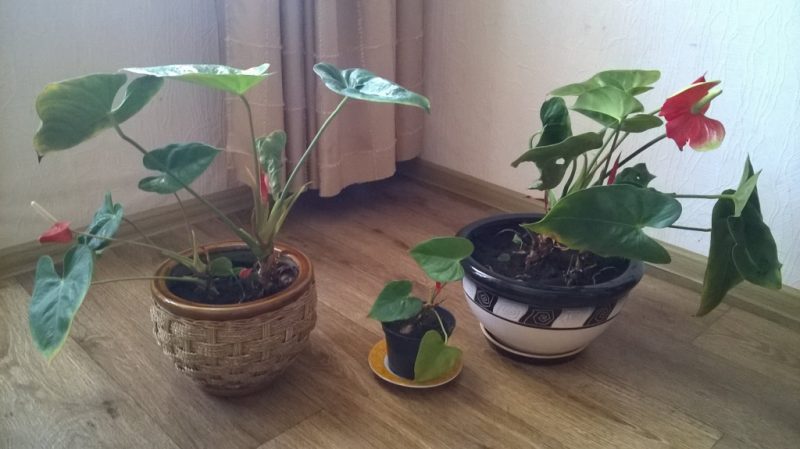
To perform the manipulation, several sequential actions are performed:
- Abundantly watered flower is removed from the container;
- The roots are freed from the ground, straightened, untwisted and inspected. All sick and dubious areas are cut out. Slices are disinfected with crushed coal.
- With a sharp tool, the rhizome is divided into several (from 2 to 5) parts that have roots. Each planted in a separate container.
Pests
Anthurium, like other indoor plants, is prone to attack by pests. The greatest danger is represented by rapidly breeding sucking insects: aphids, scale insects, spider mites and mealybugs.
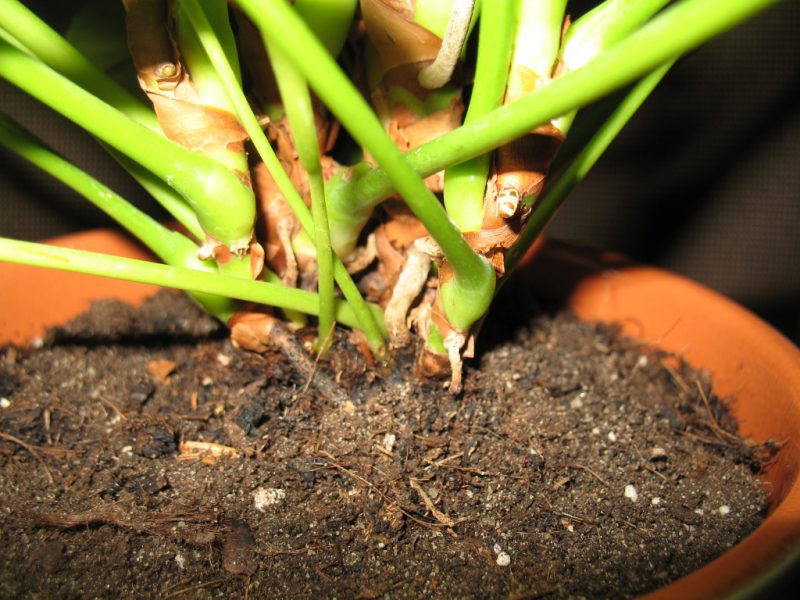
Pests settle on the surface of leaves and shoots, feed on the plant's juices, provoking yellowing and drying.
Insects are washed off with a soapy solution. Processing is carried out several times. In case of low effectiveness, insecticides are used.
Possible diseases
With gross and prolonged violations of the conditions of detention and improper care, the anthurium weakens and often gets sick. There are a lot of diseases to which he is subject, but this is not a reason for refusing to grow it or treat it.
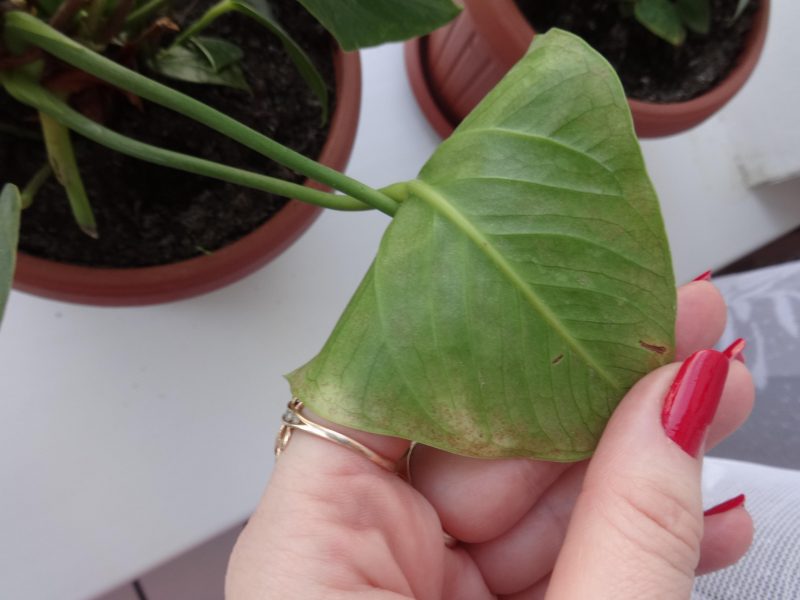
- Anthracnose (fungal infection): accompanied by the appearance of red or brown spots on the leaves and blackening of their tops. Leaves with signs of disease are removed. The plant is washed under running water and treated with any fungicide. In the absence of positive results, the flower is destroyed within a week. The pot is sanitized.
- Gray rot affects the shoots, rapidly spreading to the leaves. Sore areas are removed. The flower is treated with chemicals according to the instructions at least 3 times.
- Root rot is manifested by discoloration and subsequent rapid wilting of leaves. When transplanting on diseased roots, a clear liquid (pus) is visible. At an early stage, this disease is quite easily treated. It is enough to reduce watering and place the flower in a warm place.
- Brownish spots on the leaves are a sign of rust. Treatment consists in removing damaged leaves and repeated (after 3-4 days) the use of fungicides or alcohol solutions for 2 weeks.
Why does the plant not bloom, the leaves turn yellow?
It happens that anthurium refuse to bloom. The main reason for this is the lack of a rest period.

Do not think for a long time about what to do if the leaves turn yellow at the anthurium. So the flower expresses its dissatisfaction with the lighting, temperature conditions, violation of the soil moisture regime or its composition.
In most cases, when troubleshooting, the plant quickly restores its decorative effect.












